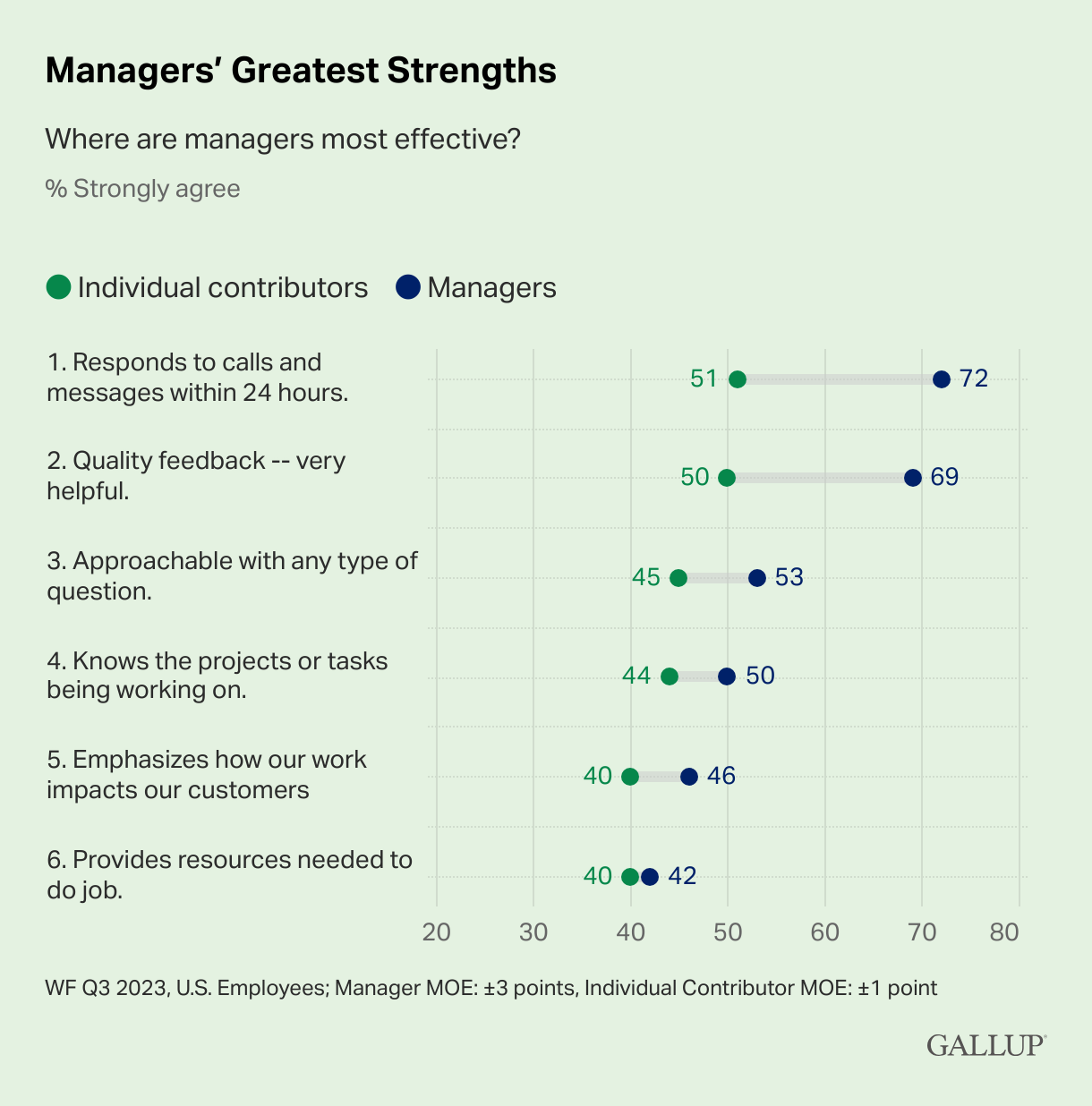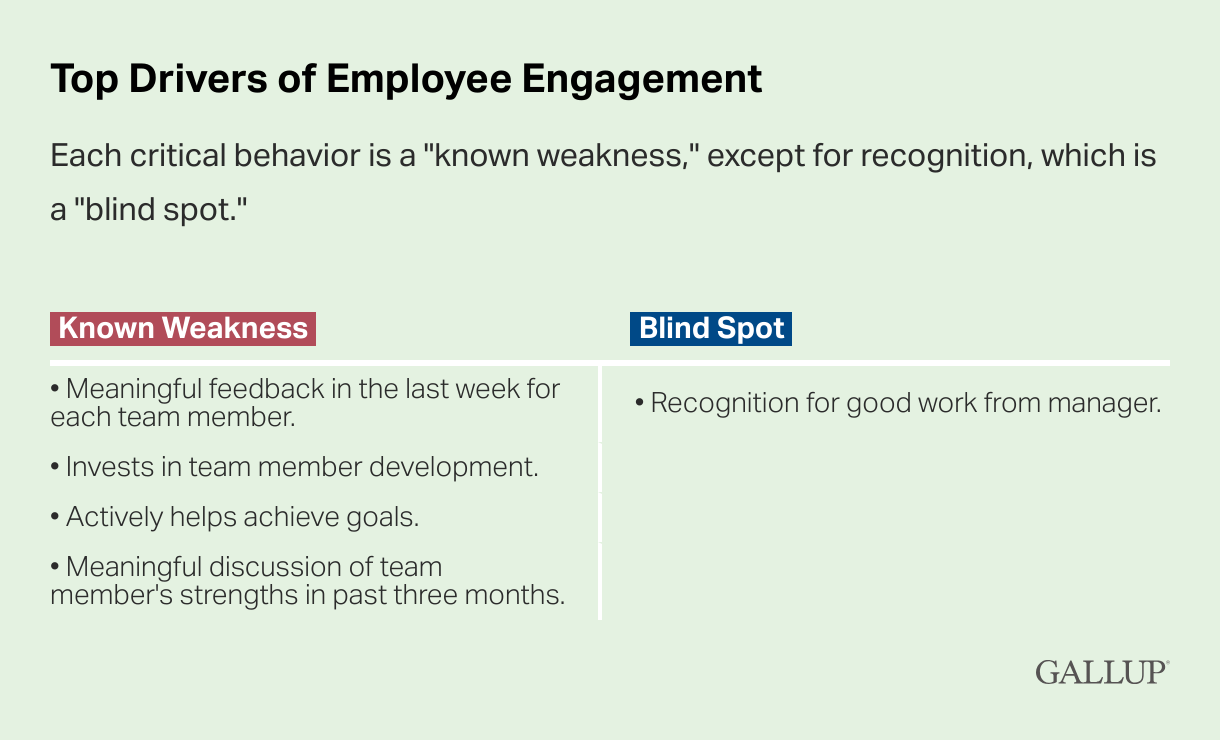Emotional Intelligence at Work
By Michael Miller

June 2024
This is Emotional Intelligence at Work, a newsletter about workplace culture, employee wellbeing, and how to create sustainable, thriving businesses. This is the browser version. If you want to get the monthly newsletter free in your inbox, you can subscribe here.
The Free, Easy Win Most Managers Are Missing
Improving a manager’s performance is probably the easiest way to boost morale and productivity within teams or organizations.
To evaluate current managerial performance, Gallup conducted a study comparing how managers think they are currently leading their team versus how employees say they are being managed. To evaluate current managerial performance, Gallup conducted a study comparing how managers think they are currently leading their team versus how employees say they are being managed. Where are managers overconfident? In what areas are managers thriving and employees agree? With any 360 assessment, the differences and similarities in answers are illuminating. (This is similar to the Six Seconds SEI 360 assessment, which compares a leader’s self-assessment to others’ perspectives on the leader’s emotional intelligence and its impact on others.)
The study used a nationally representative U.S. sample of 2,729 managers and 12,710 individual contributors.
Ratings were separated into four categories.
- Strengths — rated highest by both managers and employees.
- Known Weaknesses — rated lowest by both managers and employees.
- Blind Spots — managers rated high, but employees rated low.
- Unrecognized Strengths — employees rated high, but managers rated low.
Here’s a key takeaway from each category.
1. Managers are meeting baseline expectations
Sort of.
Most of the behaviors on which both managers and employees rated managers highly are baseline expectations of management: being responsive, approachable, informed and prepared.
The exception is high quality feedback. Though as we’ll see below, there are still major disagreements over the exact quantity and quality of that feedback.
While these are managers’ greatest strengths, there’s still massive room for improvement. Less than half of respondents strongly agreed that their manager is approachable with any type of question (45%), knows the projects or tasks being worked on (44%), emphasizes customer-centricity (40%), or provides the resources needed to do the job (40%). And while a slight majority (51%) strongly agreed that managers respond to calls and messages within 24 hours, the 21-pt gap with managers indicates that even on that most basic leadership task, a big gap persists.
In this next group, there are no big gaps: Everyone agrees these tasks aren’t happening as they should.
2. Managers are lacking higher level emotional intelligence & coaching skills
But to their credit, they’re aware of it.
The known weaknesses, or behaviors both employees and managers agree need improvement, mostly have to do with effective coaching: giving frequent, meaningful feedback, motivating employees to outstanding performance, removing barriers to success and discussing strengths. These are all about improving and getting better, and require high levels of emotional intelligence to do well.
Organizations that want to inspire high performance must embrace the manager as coach mentality, and equip managers with the coaching & emotional skills they need to set a context for optimal performance.
Why?
Gallup’s research has found these behaviors to be highly correlated to employee engagement. So when managers fall short, there are real consequences for the bottom line: less productivity, less motivation, and higher turnover.
The good news is that since managers are aware of these shortcomings, they might be more open to learning and improving in these areas.
That is less true of this next category, which is manager’s blind spots.
3. Managers think they’re recognizing good performance
But recognition is a 2-way street, and employees aren’t feeling the love.
Managers are almost twice as likely (60% vs 35%) to say that they are doing a good job recognizing their team’s hard work and contributions. That means one of two things: Managers aren’t recognizing employees’ efforts as often as they think, or they aren’t doing so in a meaningful way that sticks with employees. Either way, the data suggest employees aren’t feeling very seen or heard.
In fact, the biggest difference in the study between manager and employee perceptions is in how often they think feedback is provided. While only one in five (20%) employees say they receive feedback weekly, half of managers (50%) say they deliver it weekly.
Here’s a graph of managers’ biggest blind spots:
4. Regular, meaningful feedback is the low hanging fruit for managers
Proving regular, meaningful feedback is the biggest opportunity for improvement for most managers. It’s both the lowest rated behavior in the study and the strongest driver of employee engagement in the study.
This graph shows that while all the other top drivers of employee engagement are known weaknesses, and presumably difficult to fix or else they would, recognition is the only high value behavior that managers think they’re already doing well enough – and aren’t.
So go tell you employees (or clients that have employees) to go explicitly recognize people’s hard work and contributions.
And do the same next week.
And the week after 😊
I hope you find this information and practical tips useful.
- Emotional Intelligence at Work: The Free, Easy Win Most Managers Are Missing - June 18, 2024
- Krish and Anabel: SEL Pioneer and Mentee Share 6 Life Lessons on Empathy, Integrity, and Emotional Intelligence - June 3, 2024
- Emotional Intelligence at Work: Is There Hope for Toxic Workplaces? - May 14, 2024




